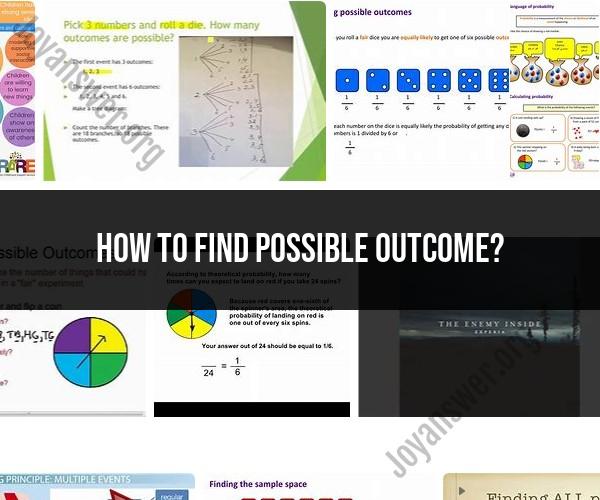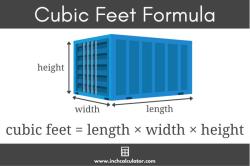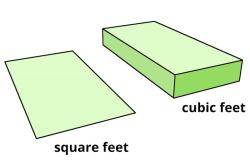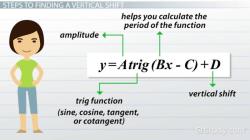How to find possible outcome?
To find the possible outcomes for a particular event, you need to consider the different ways the event can occur based on the given conditions or criteria. The method you use to find possible outcomes depends on the nature of the event and the rules governing it. Here are some general guidelines:
Define the Event: Clearly specify the event you are interested in. What is the scenario, and what are the criteria for a successful outcome?
Identify the Variables: Determine the variables or factors involved in the event. These variables could be things like the number of choices, the order of selection, or the conditions that must be met.
Use Counting Principles:
Multiplication Principle: If the event involves a series of independent choices or actions, you can use the multiplication principle. Multiply the number of choices at each step to find the total possible outcomes. For example, if you are choosing a shirt (3 choices) and pants (4 choices), there are 3 x 4 = 12 possible outfit combinations.
Addition Principle: If the event involves mutually exclusive choices (meaning only one choice can occur), you can use the addition principle. Add the number of choices in each mutually exclusive category to find the total possible outcomes. For example, if you are choosing between three desserts (cake, ice cream, pie), there are 3 possible outcomes.
Consider Combinations: In some cases, you may need to consider combinations or permutations, especially when order matters. Combinations are used when the order doesn't matter, while permutations are used when the order does matter. The formulas for combinations and permutations depend on the specific problem and criteria.
Draw a Tree Diagram: For complex events with multiple choices or conditions, you can create a tree diagram to visualize the possible outcomes at each step. This can be particularly useful for events with conditional probabilities.
Use Technology: For more complex scenarios or large datasets, you can use spreadsheet software or programming languages like Python to calculate and list possible outcomes systematically.
Here's a simple example:
Event: Choosing an ice cream flavor (vanilla, chocolate, strawberry) and a topping (chocolate syrup, sprinkles, whipped cream).
Possible Outcomes:
- Using the multiplication principle: 3 flavors x 3 toppings = 9 possible outcomes.
- You could list all 9 combinations based on the choices made.
Remember that finding possible outcomes is a fundamental step in calculating probabilities, as you need to know the total number of possible outcomes to determine the probability of a specific event occurring.
Finding Possible Outcomes: Methods and Techniques
There are a number of methods and techniques that can be used to find possible outcomes. Some of the most common methods include:
Listing: This is the simplest method for finding possible outcomes. To use this method, simply list all of the possible outcomes of the event. For example, if you are flipping a coin, the possible outcomes are heads and tails.
Tree diagrams: Tree diagrams can be used to visualize the possible outcomes of an event. To create a tree diagram, start by drawing a circle for the initial event. Then, draw a branch for each possible outcome of the initial event. Repeat this process for each subsequent event. For example, the following tree diagram shows the possible outcomes of flipping a coin and then rolling a die:
Coin flip
/ \
Heads Tails
/ \ / \
1 2 3 4 5 6
- Combinatorics: Combinatorics is the branch of mathematics that deals with counting and arranging objects. There are a number of combinatorial formulas that can be used to find the number of possible outcomes of an event. For example, the following formula can be used to calculate the number of ways to choose k objects from a set of n objects without regard to order:
nCk = n! / (k!(n-k)!)
where:
- n is the number of objects in the set.
- k is the number of objects to choose.
- n! is the factorial of n.
- k! is the factorial of k.
- (n-k)! is the factorial of n-k.
Exploring the Process of Determining All Possible Outcomes
The process of determining all possible outcomes can be challenging, especially for complex events. However, by using the methods and techniques described above, it is possible to find all possible outcomes for most events.
Here is a general process for determining all possible outcomes:
- Identify the events that make up the overall event.
- For each event, identify all of the possible outcomes.
- Use the methods and techniques described above to combine the possible outcomes of each event to find the possible outcomes of the overall event.
Counting Possibilities: Strategies for Finding Potential Results
Here are some strategies for finding potential results:
- Identify all of the possible outcomes. This may seem obvious, but it is important to first identify all of the possible outcomes before you can try to count them.
- Use a tree diagram. A tree diagram can be a helpful way to visualize all of the possible outcomes of an event.
- Use a combinatorial formula. If you are familiar with combinatorics, you can use a combinatorial formula to count the number of possible outcomes.
- Use a calculator. There are a number of calculators that can help you to count the number of possible outcomes of an event.
Conclusion
Finding possible outcomes is an important skill in many different fields, including mathematics, science, engineering, and business. By understanding the methods and techniques for finding possible outcomes, you can make better decisions and solve problems more effectively.













